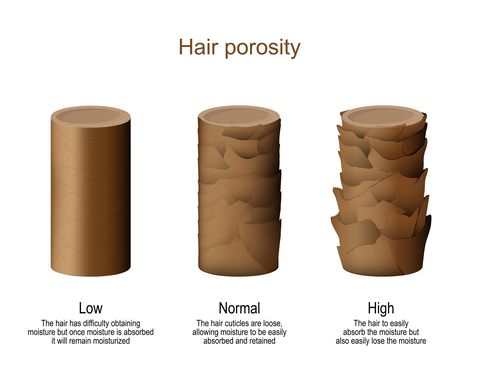Keeping your hair moisturized is a challenge, especially if you don’t know your hair porosity. What is hair porosity, you ask? Basically, it’s your hair’s ability to take in and retain moisture (i.e water). Your hair cuticle, which is the external layer of the hair’s surface, often determines your hair porosity.
According to StyleSeat stylist and natural-hair expert Kamara Brown, hair porosity comes in three categories:
- Low porosity: Very tight cuticles making it difficult for moisture to enter or escape
- Medium porosity: Slightly less tightly bound cuticles
- High porosity: Raised cuticles that look like scales on a rooftop; these cuticles easily allow moisture to penetrate through
“Understanding your hair porosity is vital when it comes to your haircare needs. Our hair strands are so delicate,” Kamara tells us. “Porosity is very important when we look at the overall feel and appearance of our hair. The more we know, the better chances we have in preventing damage to our beautiful crown while keeping more money in our pockets to prevent from becoming a product junkie.”
How can I test my hair porosity?
Recognizing the characteristics of low porosity hair can be challenging when styling hair. Between blow drying, microfiber towels and other hair-drying tools, it can be hard to notice how hair naturally interacts with water. According to StyleSeat stylist Erinn Courtney, even though she doesn’t think it’s necessary before receiving a haircare service, you can test for hair porosity at home. She recommends that to test hair porosity, you should take a cup of water and put one hair strand in it. In two to four minutes, check the strand — if it is floating, it indicates low porosity. If it sinks, that indicates high porosity. Somewhere in the middle? You probably have medium porosity.
What are the characteristics of low porosity hair?
Erinn explains that two of the key elements of low porosity hair have to do with how long it takes to dry and the build-up that can accumulate as a result of your products not being fully absorbed. “The hair may be farther on either side of a spectrum of too oily or too dry,” she says. “Conditioners and leave-ins may not work properly because they pass through the hair without remaining on the strand and could be too heavy.”
For textured strands, the challenge of keeping low porosity hair moisturized has to do with the hair naturally being dryer. Erinn says that the natural oils from the scalp have a harder time traveling down curls, making textured strands naturally dryer in comparison to straighter textures.
How to care for low porosity hair
According to Erinn, a misconception about low porosity hair is that it has “fewer cuticles, therefore making it smoother and harder to damage.” But the reality is, low porosity hair is easier to care for and requires less maintenance. The difference lies in the routine.
Hair porosity routines vary by texture. The greatest challenge for curly, kinky, and coily hair is that low porosity can lead to a feeling of brittleness and dryness. Straighter strands, however, are naturally oiler than textured hair, which means that the frequency of washing and the density of products needed are different. That said, both hair types need a moisture-focused routine and products that can penetrate the hair shaft without feeling heavy. These five steps from experts can transform your routine.
- Clarify the hair. A good clarifying shampoo is your friend! For textured strands, Kamara recommends the As I Am Curly Clarity Shampoo. For straight hair, Erinn recommends the Olaplex Nº.4 Bond Maintenance Shampoo, which is safe for daily use.
- Find the right conditioner. Got textured strands? Kamara is a fan of a moisture-focused hair mask intended to cater to curls, like the Ouidad Coil Infusion Triple Treat Deep Conditioner. Erinn suggests using the Nº.5 Bond Maintenance Conditioner, which is suitable for all hair types.
- Add heat (yes, really). According to Erinn, heat or steam can open the hair cuticle to help allow moisture and conditioners to penetrate the hair.
- Rinse with cold water. To seal in moisture, Erinn suggests rinsing out conditioner with cool water to close the hair cuticle and seal in the moisture.
- Use lightweight products. Since low porosity hair is prone to build-up, it’s important to avoid heavy products that can sit on the hair shaft. Kamara urges those with textured strands to try Mizani 25 Miracle Milk Leave-In Conditioner and top off the routine with a light oil such as the Shea Moisture Argan Oil. For looser strands, Erinn suggests the Olaplex Nº.6 Bond Smoother, which adds moisture, shine and reduces frizz.
This content is created and maintained by a third party, and imported onto this page to help users provide their email addresses. You may be able to find more information about this and similar content at piano.io



